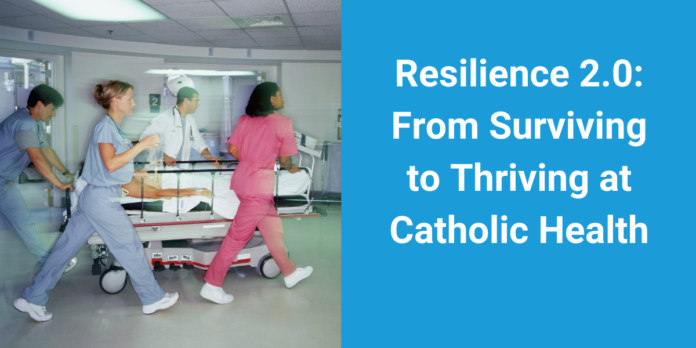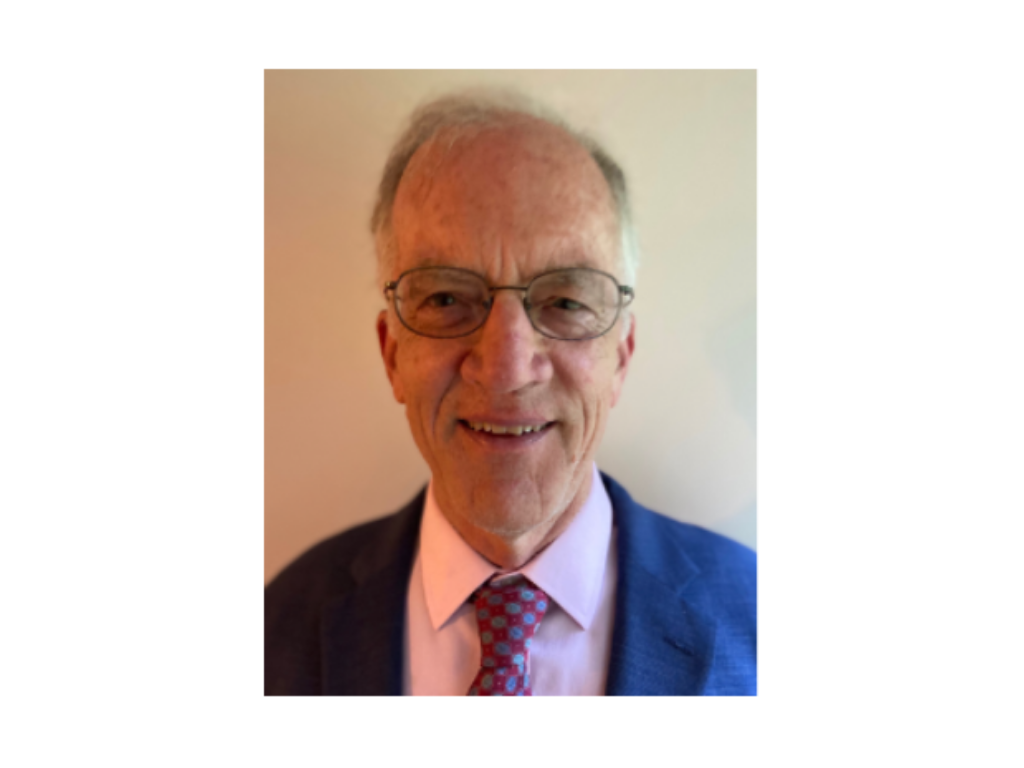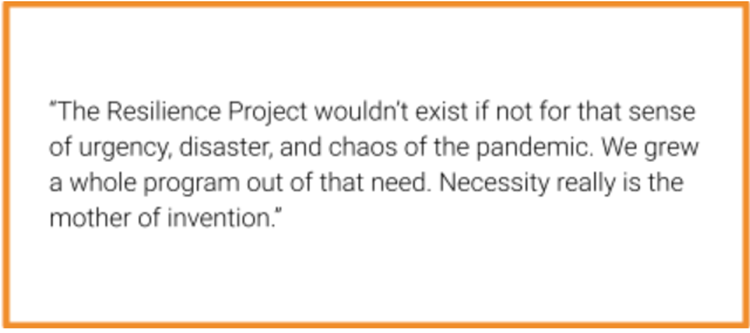
Scaling leadership development to 18,000 employees and 1,800 leaders is no easy task. Doing so across six hospitals during a global pandemic is another level of difficulty and impact.
This is exactly the challenge that was faced by Catholic Health in the spring of 2020. Their response was to move quickly and creatively. Just two weeks after the first COVID-19 surge subsided in New York, they launched the Resilience Project, a program designed to provide support to staff through the immense stress, burnout, and trauma of the pandemic.
 To learn more about how they designed and scaled the Resilience Project, I met with their Chief Learning Officer and VP of Organizational Development, Tom Bigda-Peyton.
To learn more about how they designed and scaled the Resilience Project, I met with their Chief Learning Officer and VP of Organizational Development, Tom Bigda-Peyton.
His story of the Resilience Project is powerful for its reach and its impact, as well as for its design and approach, which offer valuable insights for leadership development teams across industries and topics.

This interview has been edited for clarity and length.
The Chaos of the Pandemic Led to Three New Programs on Resilience, Diversity, and Employee Driven Improvement
Kevin Kruse: Being in leadership development in healthcare, I’m curious to learn about how the pandemic has affected your work?
Tom Bigda-Peyton: The pandemic has presented a lot of turbulence, a lot of challenge, a lot of stress, and a lot of opportunity. There's a whole new batch of things that we now do that we weren't doing before.
We put a lot of energy into building the Resilience Project, a three-phase set of programs built around resilience, stress, and burnout. We added a program on Diversity, Inclusion, and Belonging. And, we added a program on Employee Driven Improvement that focuses on bottom-up, grassroots development. We wouldn’t have had the motivation, incentive, or need to develop these new programs if not for all the challenges that the pandemic presented.
The Resilience Project especially wouldn’t exist if not for that sense of urgency, disaster, and chaos of the pandemic. We grew a whole program out of that need. Necessity really is the mother of invention.
 The Resilience Project Offers Psychological Relief to Employees in a Time of Stress, Burnout, and Trauma
The Resilience Project Offers Psychological Relief to Employees in a Time of Stress, Burnout, and Trauma
Kruse: Tell me more about the Resilience Project and how you launched it.
Bigda-Peyton: The first surge hit New York really hard, and it was rough. It was complete panic and chaos. Initially, we kept our heads down, but once the first surge calmed down a bit, we realized we had to get to our frontline workers with some relief. Not just relief with physical safety, personal protective equipment, and masks, but psychological relief.
I had a long background in different forms of team and organizational learning as an external consultant before coming to Catholic Health. For instance, I had worked with the Federal Aviation Administration (FAA) after 9/11, and my colleagues and I had done a lot with debriefing trauma. Debriefing trauma is a known practice in the military, but not so much in healthcare.
What they found at the FAA was that about nine months after September 11th, a lot of irritability began to surface in the workplace. Specifically, they found unresolved frustrations, hurt, and resentment from what had transpired on September 11th. Many people harbored sentiments like, “My boss wasn't there for me,” and “It wasn't fair.” People hold onto these difficult feelings unless they have a chance to express them.
That’s the main idea with debriefing: Give people a chance to express their difficult feelings so they don’t harbor them.
Managers Learn to Cope, Help Team Members Cope, and Create a Culture of Emotional Debriefing
Kruse: How are you delivering and scaling the Resilience Project?
Bidga-Peyton: We had three phases of rollout for the Resilience Project. We launched Resilience 1.0 in May of 2020 and ran it until just before the last surge in December 2021. Since then we have been building internal capability. Now, we're about to scale the program, which I call Resilience 2.0.
Phase I was to get some type of practical education on self-care out to the frontlines ASAP. We built and delivered a 30-minute program for front-line staff on “Coping, Self-Care, and Resilience.” Depending on the intensity of COVID-19 cases at a given hospital, the program shifted between entirely online and a physical training room with social distancing and participants dialing in.
One of the biggest challenges during this phase was that it’s really difficult for frontline healthcare workers to take any time off the floor. We worked hard to get support from their leaders. We did a lot of promotional work, and we ran the program at 1:00 pm, 4:00 pm, and 11:00 pm to reach different shifts.
Then we launched a 60-minute program for managers. We wanted them to learn the same information as the frontline workers, but we also added leadership elements. We taught managers how to identify people who need support, how to offer and provide that support, and what specific tools, tips, and techniques they could apply.
In Phase II, we did trauma debriefing sessions in three of our hospitals. We bring teams together for an hour to talk about people’s experiences with the pandemic. The idea is to build a culture of learning, where frequent debriefs are the norm. In debriefs, people should talk not only about the technical, mechanical, and medical components of their work but also about the emotional and behavioral components. In this phase, we also did short visits to Nursing Units to provide them with opportunities to talk about their experience of the Pandemic, not only the distress but also how they coped, how they supported each other, and how their managers and the wider organization helped them to cope. Finally, we talk about what they feel they accomplished, what they are proud of looking back on the Pandemic, and what we have learned that we can carry forward as we grow out of the Pandemic.
Kruse: You mentioned scaling this program again in Phase III, and more quickly this time. How are you planning to do that?
Bigda-Peyton: We're going to build a multidisciplinary team of people ready to facilitate. They will self-select, and we will select for people that are skilled at things like listening through negativity, not getting defensive, not talking over people, and not trying to convince people their feelings aren’t valid.
Our team of facilitators will constantly share knowledge, ideas, and approaches. This is how we are going to expand this program beyond a resilience support response into what we call “everyday resilience.” From day one, our goal has been to not only help people recover but also to build forward.
Peer Learning Networks Make Training Stick
Kruse: What are you doing to help make your new programs stick?
Bigda-Peyton: One of the best ways to create a high-performing learning system is to create one that’s self-organizing. In a successful peer learning network, people from the front lines up know the direction, know the mission, take initiative, and self-organize toward the goal of applying their learnings.
When a discovery has been made that is relevant, you have a peer network in place where a discovery, insight, or question can spread between people across locations. That way ideas spread faster, are shared with more people, and can be challenged, tested, and refined more quickly. These kinds of systems of peer learning already thrive at places like IBM and Verizon, which shows how well this idea can work at scale.
Kruse: What will that look like?
Bigda-Peyton: First, we're going to teach something. Then we're going to bring peers together, and facilitate a problem-solving session based on their learning. They're not just going to learn an idea; they're going to test and apply it in real time.
For example, someone will bring an actual problem they’re currently facing to the table as a case study. The facilitator will help frame their problem for a cohort of 8-10 people, then they will go around the table sharing their perspectives.
Ideally, the person starts to listen to their colleagues, and without necessarily reaching a solution, they will think about their problem differently—they will take away a new angle, an interesting idea, or a question to work from.
People will start to realize how the problems they’re facing are similar. So whether the learning was about decision-making, problem-solving, or collaboration, people begin to see how the learnings can be applied.
Applying this Example across Topics and Industries
While Catholic Health’s leadership development is in many ways specific to the healthcare industry and the pandemic, their ideas and approach can be applied more broadly. The way CH phased their approach, built out peer learning networks, and leveraged peer case studies can all be applied to any training topic and any industry.


 The Resilience Project Offers Psychological Relief to Employees in a Time of Stress, Burnout, and Trauma
The Resilience Project Offers Psychological Relief to Employees in a Time of Stress, Burnout, and Trauma



